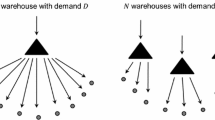Abstract
We consider a case where seven retailers, all belonging to the same organization, order independently from the manufacturer. The organization wants to evaluate the advantage of creating a centralized warehouse facility. However, the investment costs for such a warehouse are considerable and the organization is thus cautious that any cost savings must outweigh the investment cost. The multi-echelon inventory control literature does not indicate when a centralized warehouse is clearly the best option. However, there is evidence that a centralized warehouse may be advantageous for low demand items which are expensive, as opposed to inexpensive fast moving items. Also the costs of the additional warehouse (i.e., capital investment and operating costs) play an important role. Hence, whether or not a warehouse can reduce overall cost depends heavily on the additional cost of the centralized warehouse. In order to keep the investment cost low we consider an alternative to the centralized warehouse, called virtual centralized warehousing. In the latter system no additional investment costs are necessary (i.e., the existing retailers have excess capacity at their current facilities) and the benefits of central warehousing are achieved.
Zusammenfassung
Die vorliegende Fallstudie beinhaltet ein stochastisches Lagerhaltungsproblem für ein System mit sieben unabhängig agierenden Vertriebslägern für Ersatzteile. Neben einer Optimierung der Lagerdispositionsregeln für das bestehende, einstufige System soll die Frage der Vorteilhaftigkeit einer Errichtung eines Distributionssystems mit einem zusätzlichen Zentrallager geklärt werden, wie sie vielfach in der Literatur für Fälle sporadischer Nachfrage und hochwertiger Güter empfohlen wird. Als dritte Alternative analysiert der Beitrag das Konzept sogenannter virtueller Zentralläger, bei dem jedes der Vertriebsläger die Aufgabe eines Zentrallagers für ein oder mehrere Produkte übernimmt. Für das betrachtete Unternehmen erweist sich die Errichtung eines Zentrallagers gegenüber der unabhängigen Disposition der Vertriebsläger in bezug auf die laufenden Kosten für Beschaffung, Transport und Lagerhaltung als unvorteilhaft, während ein System mit virtuellen Zentrallägern unter denselben Kostengesichtspunkten die beste Alternative darstellt.
Similar content being viewed by others
References
Ehrhardt R (1979) The Power Approximation for Computing (s, S) Inventory Policies. Manag Sci 25(8): 777–786
Ehrhardt R, Mossier C (1984) A Revision of the Power Approximation for Computing (s, S) Policies. Manag Sci 30(5): 619–622
Ehrhardt R, Schultz C, Wagner H (1981) (s, S) Policies for a Wholesale Inventory System. In: Schwarz L (ed) Multi-Level Production/Inventory Control Systems: Theory and Practice. TIMS Studies in the Management Sciences, 16, North-Holland Publishing Company, Amsterdam, pp 145–161
Schneider H, Rinks D, Kelle P (1995) Power Approximations for a Two-Echelon Inventory System Using Service Levels. Prod Oper Manag 4(4): 381–400
Schneider H, Ringuest J (1990) Power Approximation for Computing (s, S) Policies using Service Level. Manag Sci 36(7): 822–834
Schwarz L (1989) A Model for Assessing the Value of Warehouse Risk-Pooling: Risk-Pooling Over Outside Supplier Lead Times. Manag Sci 35(7): 828–842
Author information
Authors and Affiliations
Rights and permissions
About this article
Cite this article
Schneider, H., Watson, E. An analysis of warehouse and distribution strategies. OR Spektrum 19, 169–175 (1997). https://doi.org/10.1007/BF01545520
Received:
Accepted:
Issue Date:
DOI: https://doi.org/10.1007/BF01545520




